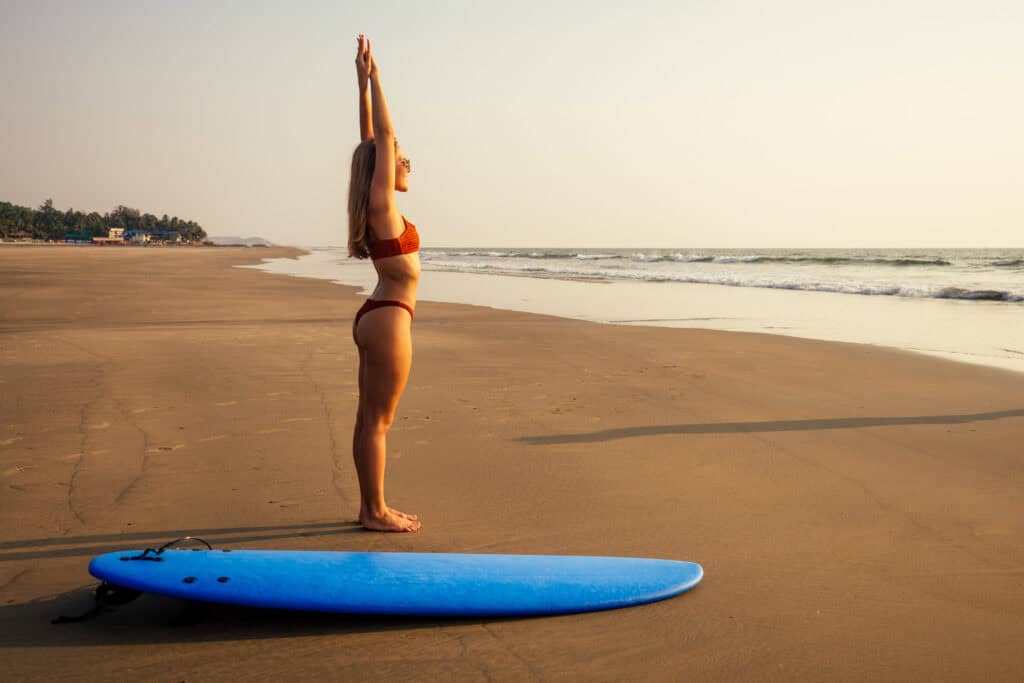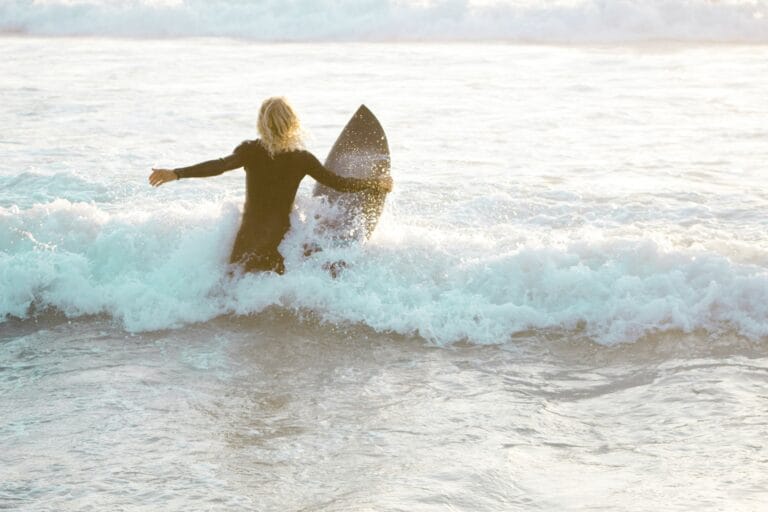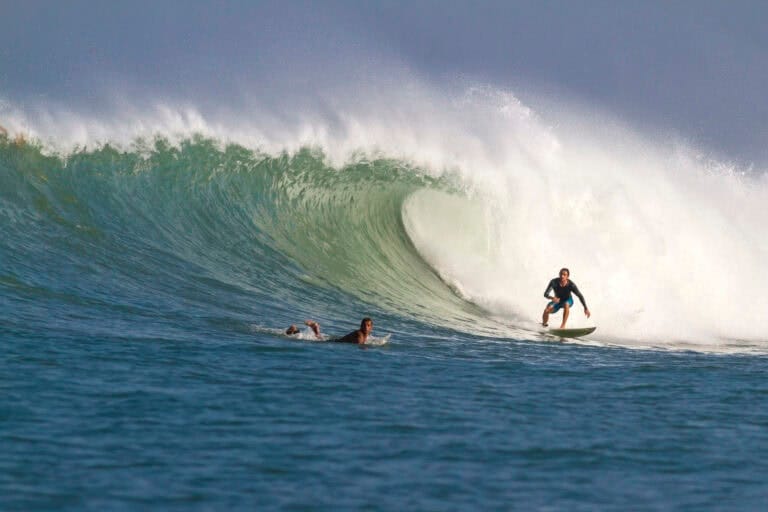Welcome to our Beginner Surfing Guide, where we will introduce you to the essential skills and knowledge needed for a successful start in the world of surfing. As a spiritual seeker or someone looking to improve your well-being, this guide is tailored specifically for you.
In this comprehensive post, we will cover topics such as choosing the right surfing spot by understanding wave types and conditions, as well as seeking advice from local surf schools or seasoned surfers. We’ll also discuss important aspects of surf etiquette and respect that every beginner should be aware of.
Furthermore, our Beginner Surfing Guide delves into essential gear selection for newcomers, mastering the pop-up technique for smooth transitions on waves, and efficient ways to paddle out. You’ll also learn how to catch your first wave with proper timing and positioning while adjusting body weight distribution during takeoff.
Last but not least, we will provide valuable information on surf-specific exercises that can help build strength in key muscle groups required for optimal performance on the water. So let’s dive in!
Choosing the Right Surfing Spot
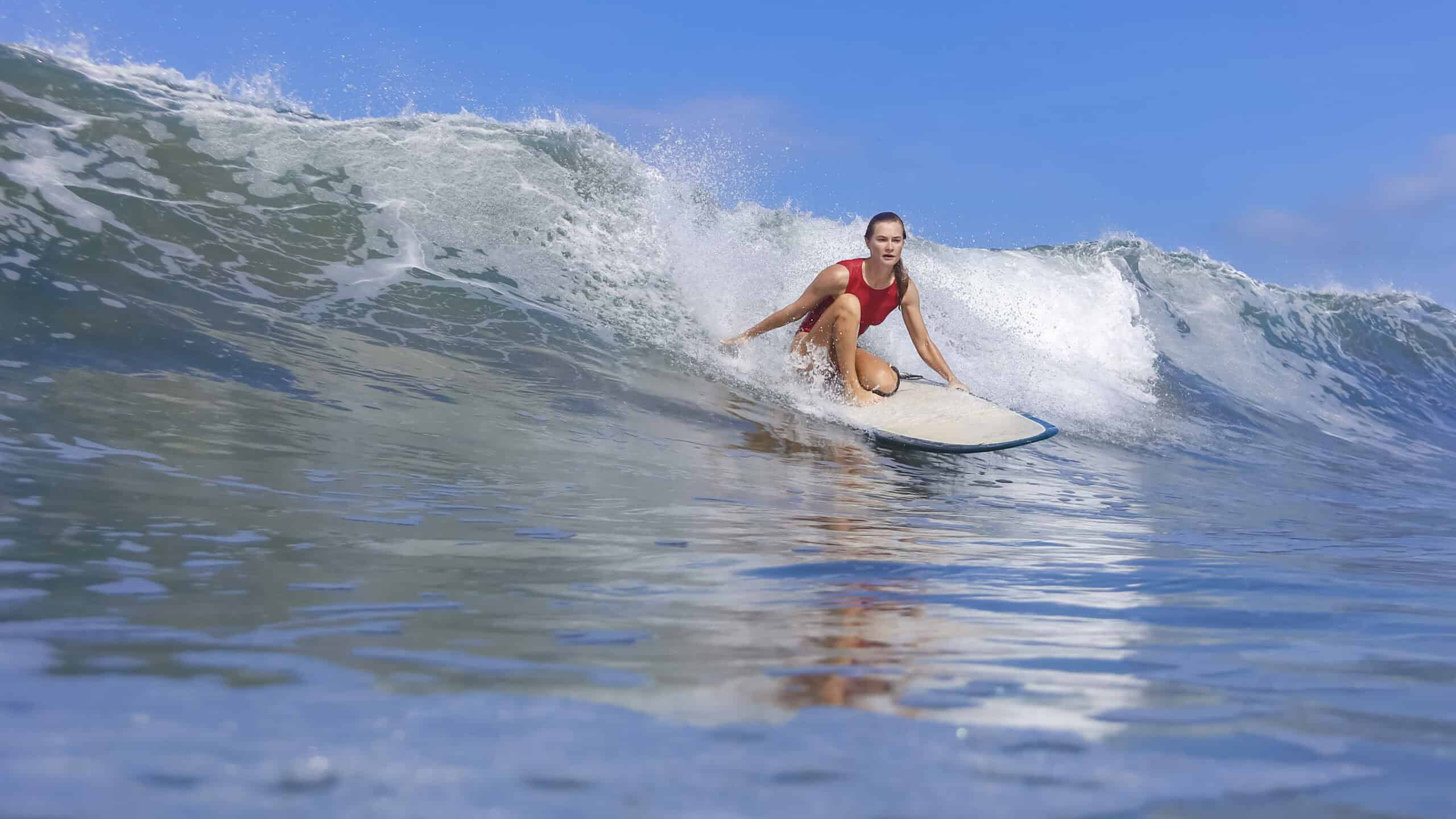
As a beginner, it’s crucial to select an appropriate surfing location that matches your skill level. Start with gentle waves and gradually progress as you gain confidence and experience. Research local surf spots or ask experienced surfers for recommendations.
Understanding Wave Types and Conditions
Different wave types can significantly impact your surfing experience. As a beginner, look for beach breaks where waves break over sandy bottoms, providing softer landings if you wipe out. Familiarize yourself with wave conditions such as size, power, and direction before venturing into the water.
- Size: Opt for smaller waves (1-3 feet) when starting out to build confidence without feeling overwhelmed by larger swells.
- Power: Gentle rolling waves are ideal for beginners as they provide enough push without being too forceful or challenging to catch.
- Direction: Select onshore wind conditions which create smoother wave faces perfect for learning how to ride them successfully.
Seeking Advice from Local Surf Schools or Seasoned Surfers
If you’re unsure about suitable beginner spots in your area, consult local surf schools or seek advice from more experienced surfers who know the best locations tailored towards novices. They can offer valuable insights into less crowded areas with optimal conditions suited specifically for those just starting their journey in surfing. WannaSurf is an excellent resource featuring maps of popular surf spots worldwide, including detailed information on wave conditions and skill level requirements.
Once you’ve picked the ideal surfing area, it’s vital to observe and adhere to surf etiquette in order to make sure everyone has a pleasant and safe time. To ensure a pleasant time in the water, let’s look into proper ways to interact with other surfers while riding waves.
Surf Etiquette and Respect
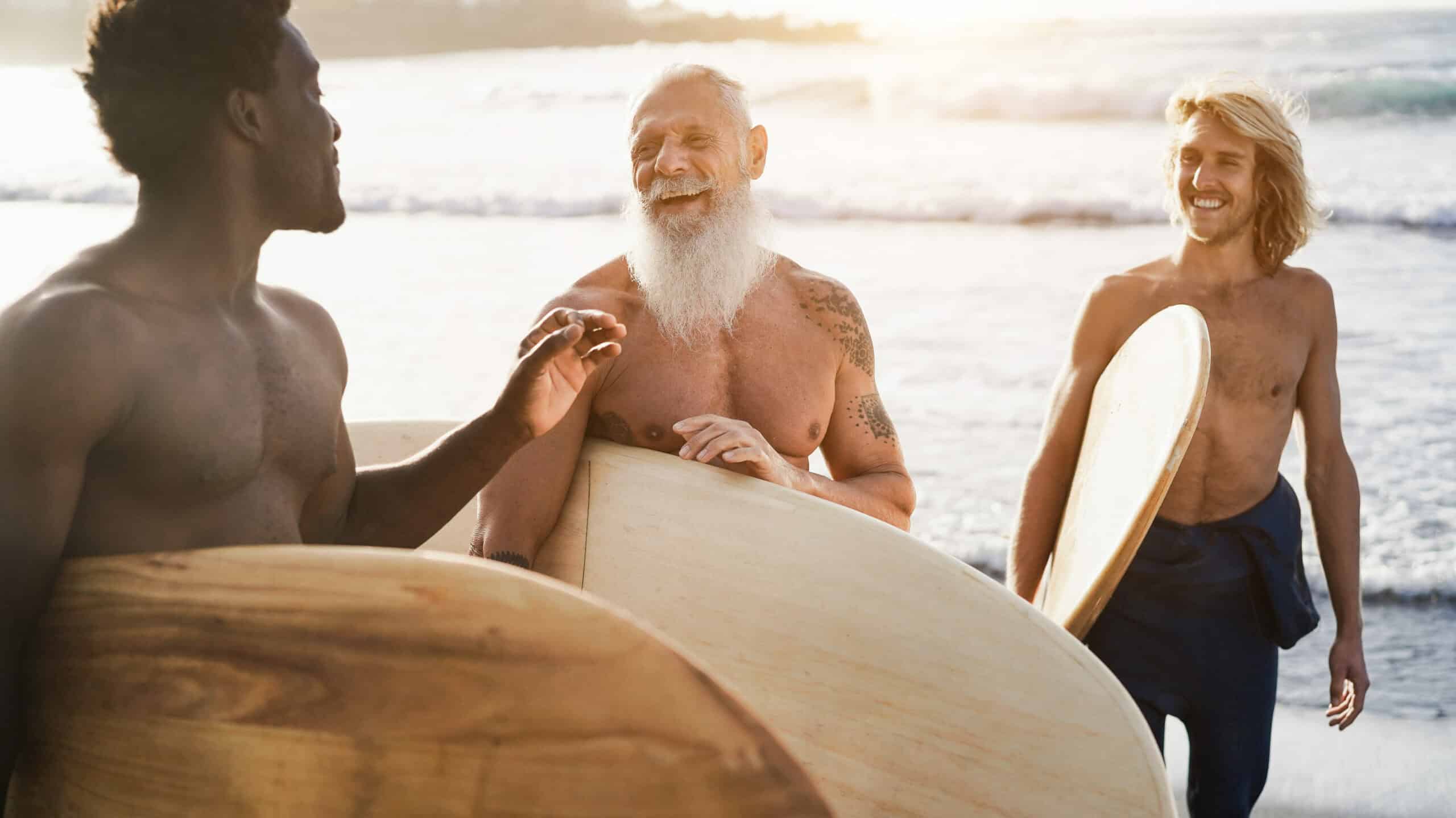
When attempting to surf, being courteous of others in the water is essential. Following basic etiquette rules will not only help you avoid conflicts with fellow surfers but also contribute to a positive surfing environment for everyone involved. In this section, we’ll discuss some key aspects of surf etiquette and how you can demonstrate respect while catching waves.
Learning Priority Rules When Catching Waves
The first step towards understanding surfing etiquette is knowing who has priority when multiple surfers are attempting to catch the same wave. Generally speaking, the surfer closest to the peak (the point where the wave breaks) has priority. This means that if someone else is already up and riding or paddling for a wave, it’s your responsibility as a beginner surfer not to drop in on their ride.
- Don’t drop in: Avoid taking off on a wave if another surfer is already riding or about to catch it.
- Paddle wide: If you’re paddling out and see an experienced surfer coming down the line, try moving around them instead of getting directly in their path.
- Honor local customs: Different surf spots may have unique unwritten rules; observe what other experienced surfers do at each location before joining them in the lineup.
Communicating Effectively with Fellow Surfers
Maintaining open communication with those around you helps create harmony among all users sharing space within any given break zone. Here are some tips for effective communication while surfing:
- Be polite: Greet fellow surfers with a smile and acknowledge their presence when you enter the water.
- Ask for advice: If you’re unsure about local rules or conditions, don’t hesitate to ask more experienced surfers or a nearby surf instructor.
- Avoid yelling: Surfing is meant to be a peaceful experience; try not to raise your voice unless it’s necessary for safety reasons.
Incorporating these etiquette tips into your surfing routine will help ensure that both you and those around you can enjoy the waves in harmony. Remember, respect goes a long way in creating positive experiences for everyone involved.
It is important to remember that respect for fellow surfers and the ocean are essential elements of any successful surfing experience. Time to choose the correct equipment for those just starting out, with an emphasis on respecting both other surfers and the ocean.
Essential Gear for Beginners
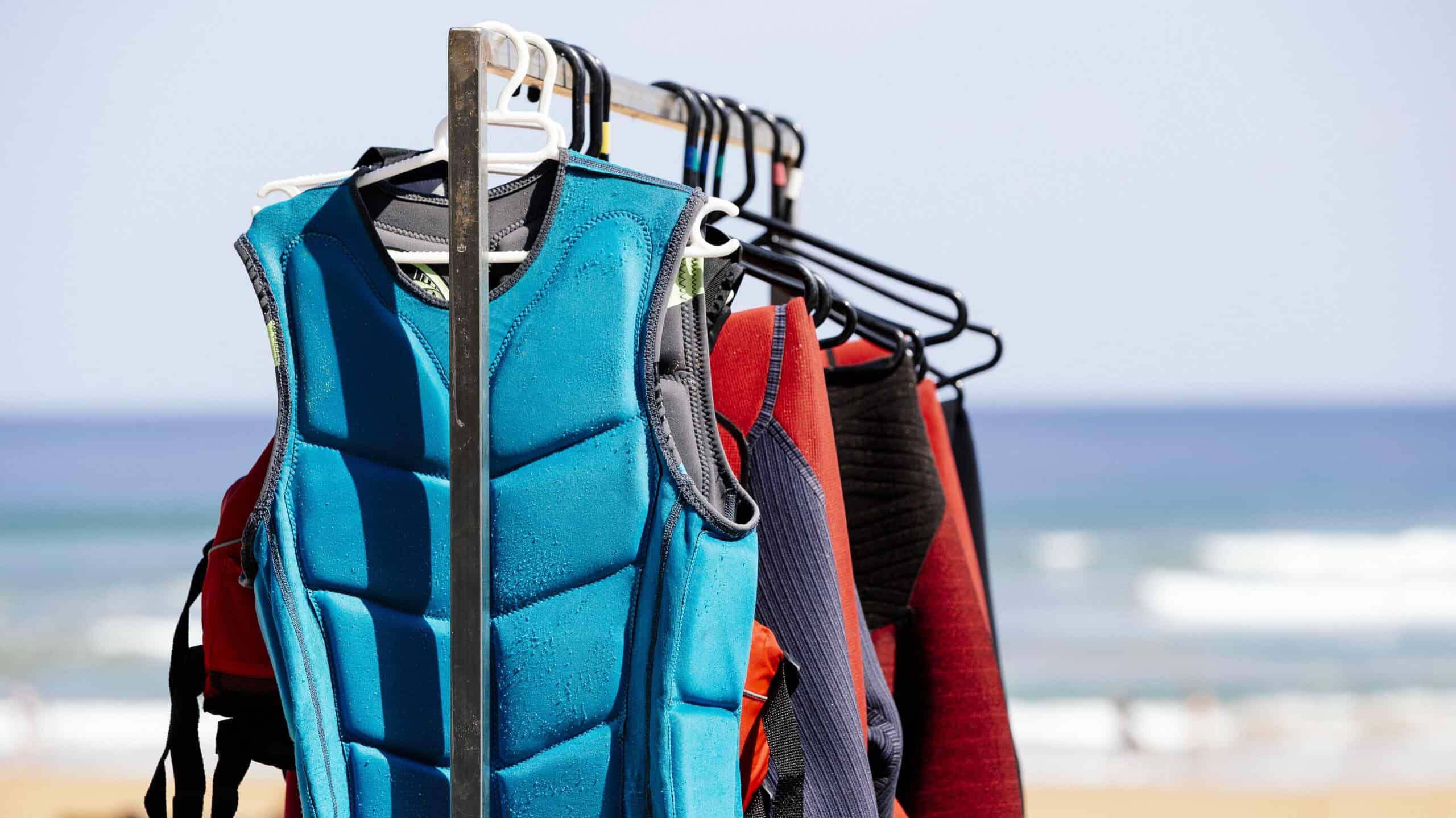
To start surfing safely, invest in some necessary gear including a suitable board for beginners (usually larger), a snug rash guard to protect against sunburns, swimwear that stays put while riding waves, wax for grip on the board surface, and a leash to keep your board close by. This essential equipment will not only make your surf sessions more enjoyable but also help you progress faster as you develop your skills.
Selecting an Appropriate Beginner-Friendly Board
When it comes to choosing the right beginner surfboard, size matters. A larger and wider foam board provides better stability and buoyancy, making it easier for newbies to catch waves and maintain balance. As you gain experience and confidence in the water, you can gradually transition to smaller boards designed for specific wave conditions or styles of surfing.
- Foam boards: Also known as soft-top surfboards are ideal beginner options due to their durability, and safety features like rounded edges & soft fins.
- Longboards: These are typically over 8 feet long with plenty of volume which makes them perfect choices if looking into progressing from foamies to something more advanced yet still forgiving enough during the early stages of learning how to ride waves properly.
Importance of Using Sunscreen Alongside Rash Guards
A snug-fitting rash guard is crucial when starting out in surfing because it helps prevent painful sunburns on your back while spending hours paddling and waiting for waves. However, it’s important to remember that a rash guard alone may not provide complete sun protection. Prior to surfing, lather up with a water-resistant sunscreen boasting an SPF of 30 or more for optimal sun protection.
Additionally, consider investing in other protective gear such as:
- Surf hat: A wide-brimmed hat designed specifically for surfing can shield your face from harmful UV rays while still staying securely on your head during wipeouts.
- Sunglasses: Polarized sunglasses protect your eyes from glare and potential damage caused by prolonged exposure to sunlight reflected off the water’s surface.
Other Essential Surf Gear
Beyond boards and sun protection, there are several other items that will make your surf lessons more enjoyable and productive:
- Leash: This essential piece of equipment attaches to both your ankle and board ensuring they stay close together even after falls – preventing any runaway situations where one might get lost at sea.
- Wax: Applying wax onto the top deck provides the grip needed so feet don’t slip off easily when standing up while riding the wave; choose the appropriate type based on temperature conditions (tropical vs cold).
Having the right gear is essential for a successful and enjoyable beginner surfing experience. Let’s now focus on honing the art of popping up.
Mastering the Pop-Up Technique
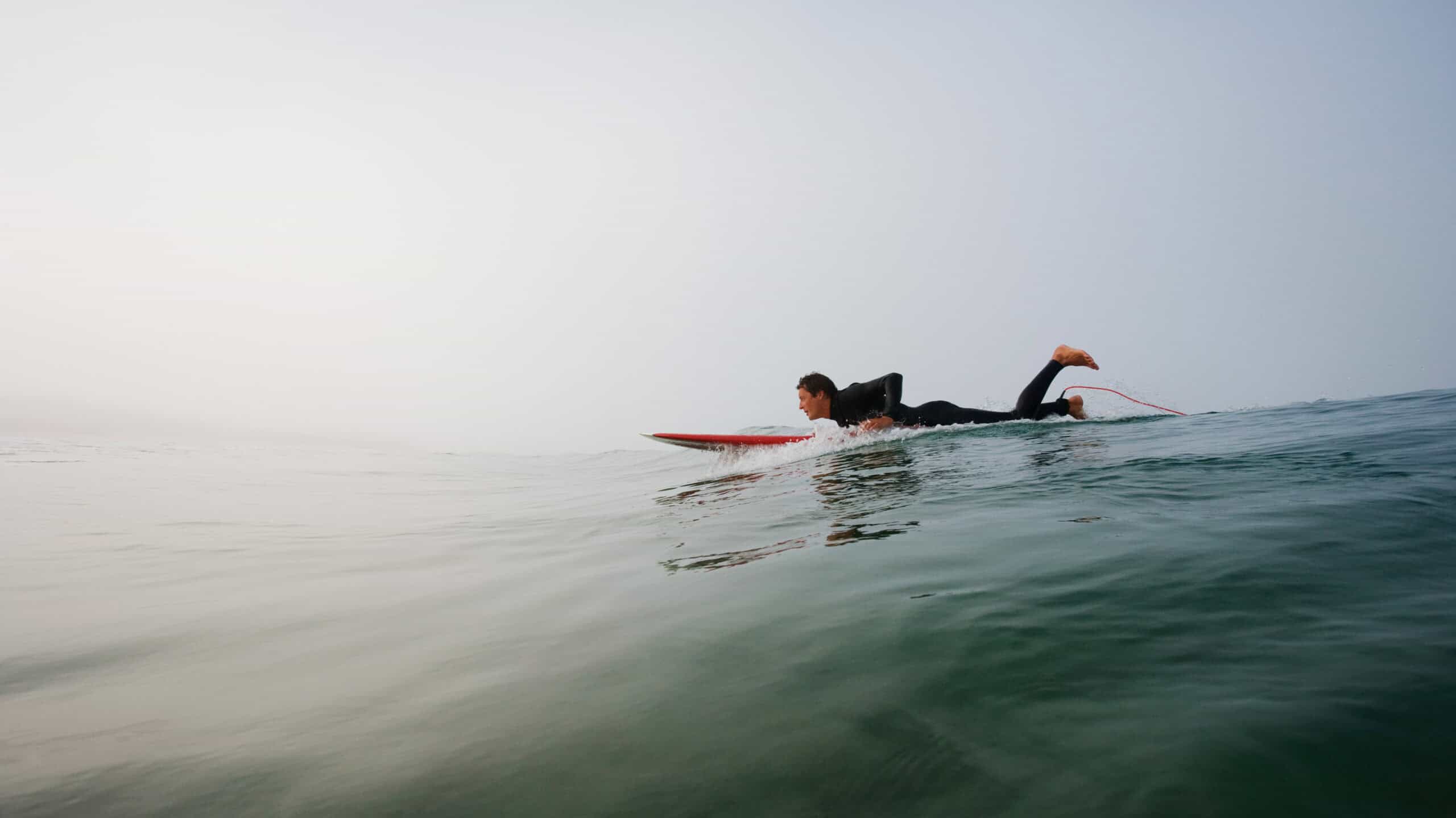
The pop-up is one of the most critical skills required when learning how to catch waves successfully. Practice this technique on dry land before attempting it out at sea; focus on transitioning smoothly from lying down flat on your stomach into standing up quickly all within one motion.
Key Elements of Proper Pop-Up Form
To execute a proper pop-up, follow these essential steps:
- Lie flat: Start by lying down on your surfboard with your chest aligned over the middle and feet together.
- Paddle position: As you feel a wave approaching, begin paddling using both arms in unison while maintaining balance on the board. Keep an eye out for our guide to improving paddle power.
- Hand placement: Place your hands firmly beside your chest or shoulders as if preparing for a push-up.
- Push and slide forward: Push off from the ground (or water) using your arms while simultaneously sliding both feet beneath you, landing in a crouched stance with knees bent and weight centered over the board.
- Rise up slowly but surely: Gradually straighten your legs until fully upright keeping your eyes focused ahead towards where you want to ride the wave.
Tips for Improving Speed During Transitions
In order to improve speed during transitions, consider incorporating the following suggestions for practice routine:
- Strengthen upper body muscles: Having stronger arm-shoulder strength will allow more efficient powerful pushes.
- Visualize success: Spend time visualizing the perfect pop-up technique, imagining each step process as smoothly and quickly as possible. This mental practice can translate into actual performance in the water.
- Record analyze: Ask a friend to film you when practicing pop-ups either on land or sea, then review the footage to identify areas of improvement and work on those specifically during sessions.
Remember, mastering the pop-up technique takes time and dedication. Don’t get discouraged if you don’t nail it right away; keep practicing and refining your form, and soon enough, you’ll be catching waves like a pro.
Mastering the pop-up technique is a fundamental skill that all surfers should strive to perfect. Now, let’s move on to out efficiently – an essential part of catching waves in any condition.
Paddling Out Efficiently
Paddling out through breaking waves can be challenging, but mastering efficient techniques will help conserve energy, allowing more time spent actually surfing rather than struggling against incoming swells. Learn about turtle rolling and duck diving methods, which enable easier passage past break zones.
Turtle Rolling for Longboards and Beginner Surfers
If you’re using a longboard or foam board as your beginner surfboard, the turtle roll is an effective method to paddle out. To execute this technique:
- Approach the oncoming wave while lying down on your board with your chest facing down.
- As the wave approaches, grab both rails (sides) of your surfboard near its nose.
- Kick up slightly with your legs and flip over onto your back so that the bottom of the board faces upwards towards the sky.
- Hug tightly onto the rails as you allow yourself to sink beneath the surface of the water just enough for waves to break above without knocking you off balance.
Turtle rolling requires practice to perfect timing; however, once mastered it becomes an invaluable tool for conserving precious paddle power during sessions.
Duck Diving for More Advanced Board Types
Duck diving is another technique used by experienced surfers when paddling out through wave breaks. This method works best on shortboards due to their smaller size maneuverability compared to larger boards like longboards and foamies that beginners typically use. Follow these steps to perform successful duck dive:
- As the wave approaches, position yourself in a prone position on your surfboard.
- Grab both rails near the nose of your board and push it downwards into the water using upper body strength; aim to submerge the front half beneath the surface before impact occurs between the wave itself.
- Bend knees, lift feet up off the deck, kick down with legs, propel remainder under incoming swell while maintaining grip tightness along sides ensuring stability control throughout the process.
Duck diving can be challenging for beginners but is an essential skill to learn as you progress towards more advanced surf spots. Practice makes perfect, so don’t get discouraged if you struggle at first – keep trying until it becomes second nature.
Paddling Out Efficiently is an important skill to learn as a beginner surfer, and mastering the techniques of turtle rolling and duck diving will help you become more confident in the water. Moving on from there, it’s time to focus on catching your first wave by learning how to properly time and position yourself for takeoff.
Catching Your First Wave
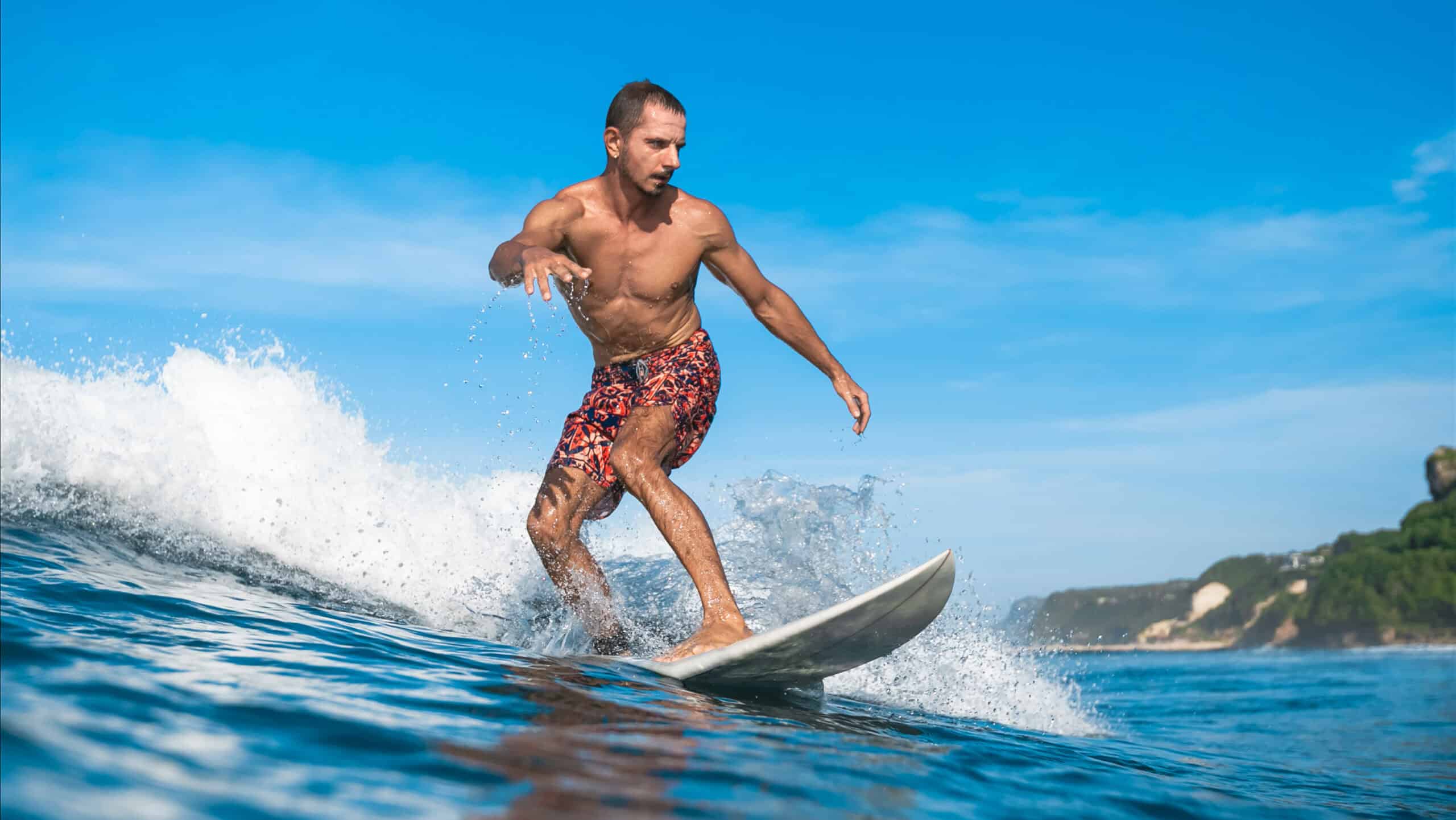
As a beginner surfer, it’s key to comprehend the art of catching swells. Start by paddling calmly onto the wave using 30% – 50% of your paddle power, then execute your pop-up technique all in one motion as you feel the wave lift beneath you. In this section, we will discuss timing and positioning when catching waves and adjusting body weight distribution during takeoff.
Timing and Positioning When Catching Waves
To successfully catch a wave, proper timing and positioning are crucial factors. Begin by observing experienced surfers or taking surf lessons from a qualified surf instructor who can guide you on where to position yourself based on different types of wave breaks. Here are some tips for improving your timing:
- Observe the ocean: Pay attention to the rhythm of incoming sets; this will help you predict when a suitable wave is approaching.
- Paddle early: Start paddling before the wave reaches you so that you can match its speed and be ready for takeoff.
- Maintain balance: Keep your center of gravity low while paddling out towards an incoming swell – this helps maintain stability during acceleration.
Adjusting Body Weight Distribution During Takeoff
The moment between catching a wave and standing up on your beginner surfboard is critical because improper weight distribution can lead to wipeouts or missed opportunities. As soon as you feel the momentum from the approaching swell propelling forward, adjust body weight accordingly:
- Shift your weight slightly forward to help generate speed down the face of the wave.
- As you execute your pop-up, distribute body weight evenly between both feet while maintaining a low stance for stability.
- Once standing, continue adjusting weight distribution based on wave conditions – lean into turns or compress during steep sections to maintain control and balance.
Taking these steps will ensure that you are well-prepared for catching waves with confidence. Remember always to practice in beginner spots where fellow surfers share similar skill levels and respect surfing etiquette. With time, patience, and perseverance, you’ll soon be riding waves like an experienced surfer.
Catching your first wave is an exhilarating experience that will have you hooked on surfing for life. With a few exercises to strengthen the body, riders can take their skills to the next level and make catching waves even easier.
Surf-Specific Exercises for Strength Building
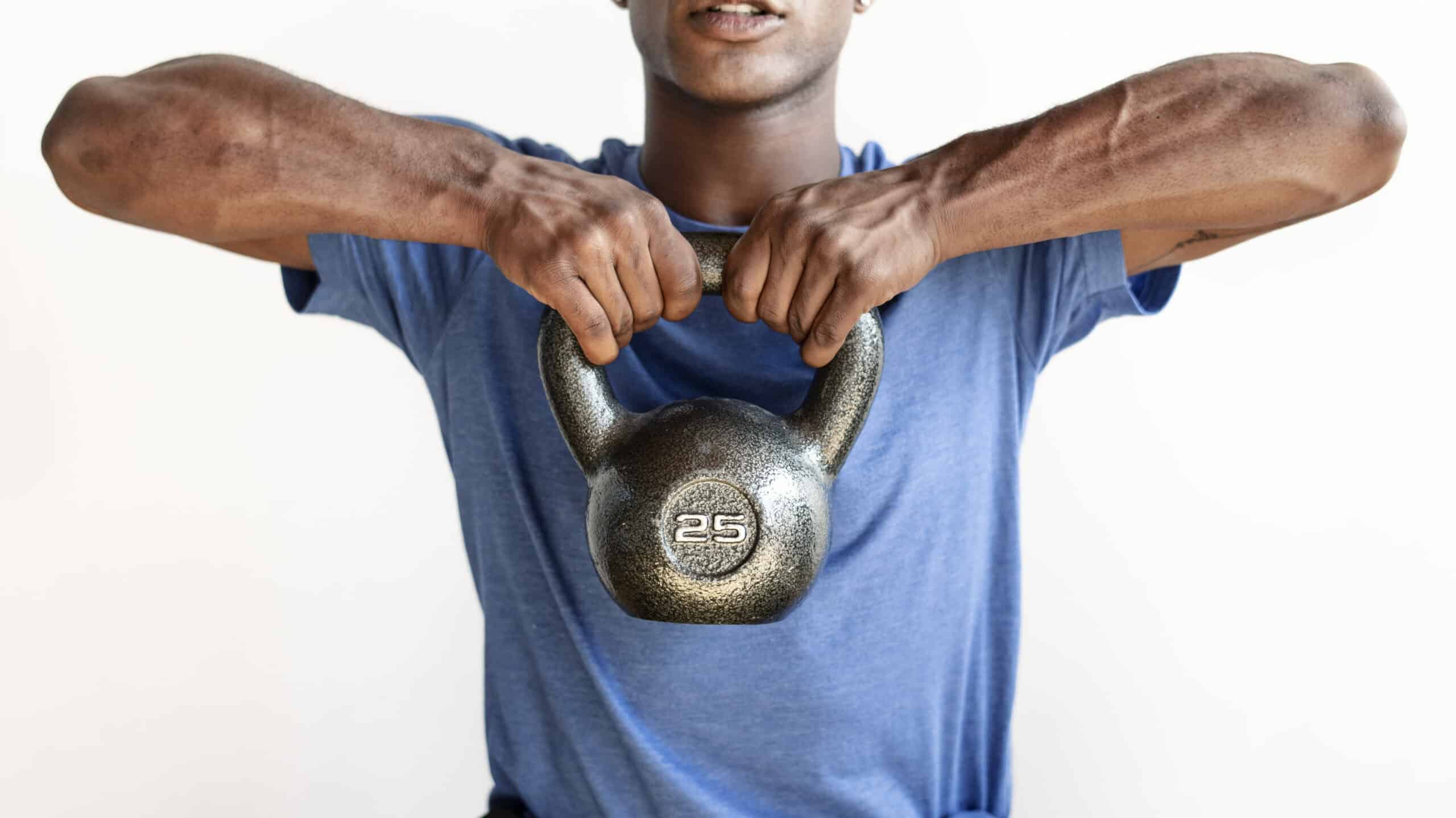
To improve your surfing skills faster, incorporate exercises that target key muscle groups used while riding waves. Focus on strengthening deltoid muscles (shoulders), posterior chain muscles (lower back & glutes), and core stability through targeted workouts.
Deltoid-Strengthening Exercises like Lateral Raises or Overhead Presses
Strong shoulders are essential for paddling power and maintaining balance on the board. To strengthen your deltoids, try incorporating lateral raises and overhead presses into your workout routine:
- Lateral Raises: Stand with feet shoulder-width apart, holding a dumbbell in each hand at your sides. Slowly lift both arms up to shoulder height, then bring them back down. Repeat for 10-12 reps.
- Overhead Presses: Hold a pair of dumbbells at shoulder level with palms facing forward. Push the weights up above your head until your arms are fully extended before lowering them back down to starting position. Perform 10-12 reps.
Posterior Chain Movements such as Deadlifts or Kettlebell Swings
Your posterior chain plays a crucial role in generating power during turns and maintaining proper posture while surfing. Strengthen these muscles by incorporating deadlifts and kettlebell swings into your fitness regimen:
- Deadlifts: With feet hip-width apart, bend at the hips and knees to grip a barbell or set of dumbbells on the ground; keep chest lifted and spine neutral throughout the movement. Drive through heels to stand up straight, lifting the weight off the floor; slowly return the weight back down without rounding the lower back.
- Kettlebell Swings: Stand with feet shoulder-width apart, holding a kettlebell in both hands. Bend knees slightly and hinge at hips to swing the kettlebell back between legs; then, thrust hips forward to propel the weight up to chest height before allowing it to swing back down (source).
Core-Strengthening Exercises for Improved Balance and Stability
A strong core is vital for maintaining balance on your surfboard and executing maneuvers. Incorporate these exercises into your routine for improved stability while surfing:
- Planks: Get into a push-up position but rest on your forearms instead of your hands; hold the body in a straight line from head to toe without letting hips sag or lift too high. Maintain the posture for as long as you can.
- Russian Twists: Sit on the ground with knees bent, and heels touching the floor; lean your torso back slightly and hold a weighted object (like a medicine ball) at chest level. Twist the upper body side-to-side, tapping weight gently on each side of the body. Perform 10-12 reps per side.
Incorporating these targeted exercises into your regular fitness routine will help you build strength specific to surfing movements, ultimately enhancing your overall performance out in the waves.
Frequently Asked Questions Beginner Surfing Guide
What do I need to know about surfing for beginners?
To start surfing, you should first choose a beginner-friendly spot with gentle waves and seek advice from local surf schools or experienced surfers. Familiarize yourself with surf etiquette, invest in essential gear like a suitable board and rash guard, and practice the pop-up technique. Focus on paddling out efficiently using turtle rolling or duck diving methods before attempting to catch your first wave.
How to surf? 7 tips beginners need to know to start surfing?
- Select an appropriate beginner-friendly location
- Learn basic surf etiquette
- Invest in essential gear such as a soft-top board and rash guard
- Master the pop-up technique through consistent practice
- Paddle out efficiently using turtle rolling or duck diving methods
- Familiarize yourself with timing and positioning when catching waves
- Incorporate surf-specific exercises into your fitness routine for strength building
Can I teach myself surfing?
You can teach yourself how to surf; however, it’s recommended that you take lessons from qualified instructors at a local surf school. They will provide valuable guidance on techniques, safety measures, equipment usage, and proper etiquette. Learning from professionals helps accelerate progress while minimizing risks associated with self-teaching.
How do beginners surf safely?
To ensure safe surfing practices as a beginner:
- Avoid crowded lineups where more advanced riders may be present;
- Choose a suitable board with adequate buoyancy and stability;
- Learn basic water safety skills, such as swimming and rip current awareness;
- Always use a leash to prevent losing your board; and
- Surf with a buddy or in areas monitored by lifeguards.
Conclusion
For advanced surfers, essential elements to keep in mind while riding the waves should be taken into consideration. From choosing the right surf spot and respecting fellow surfers’ etiquette to mastering pop-up techniques and selecting appropriate gear, this Beginner Surfing Guide provides valuable insights for anyone looking to catch their first wave.
By following these tips and tricks, you can build your confidence on the board while also improving your overall physical health and well-being through surfing-specific exercises. So whether you’re planning a solo trip or seeking guidance from an experienced instructor, use this guide as your go-to resource for all things beginner surfing.
